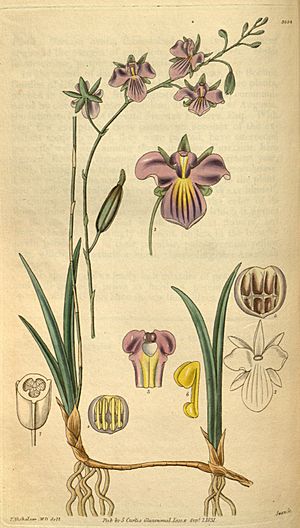Tetramicra canaliculata facts for kids
Quick facts for kids Tetramicra canaliculata |
|
|---|---|
 |
|
| Tetramicra elegans (as syn. Brassavola elegans) - Illustration in Curtis's Botanical Magazine, vol. 58 (N.S. 5) pl. 3098 (1831) | |
| Scientific classification | |
| Genus: |
Tetramicra (plant)
|
| Species: |
canaliculata
|
| Synonyms | |
|
|
Tetramicra canaliculata is a fascinating type of orchid! Orchids are beautiful flowering plants, and this one belongs to a group called Laeliinae. You can find this special orchid growing in warm places like Florida, the islands of Hispaniola and Puerto Rico, Trinidad, and other smaller islands in the Lesser Antilles. It's quite important because it's the main example, or "type species," for its entire group of plants.
Contents
About the Tetramicra canaliculata Orchid
This orchid is known for its unique look. Like many orchids, it has beautiful flowers that can attract pollinators. The name canaliculata comes from a Latin word meaning "channeled" or "grooved." This likely refers to a specific feature of the plant, perhaps its leaves or parts of its flowers.
Orchids are a very diverse family of plants. They grow in many different environments around the world. Tetramicra canaliculata prefers tropical and subtropical climates. It thrives in areas with plenty of warmth and humidity.
Where This Orchid Grows
Tetramicra canaliculata is native to several regions. It is found in the sunny state of Florida in the United States. It also grows naturally across the Caribbean. This includes large islands like Hispaniola (where Haiti and the Dominican Republic are located) and Puerto Rico.
Further south, it can be found on the island of Trinidad. It also lives on many of the smaller islands that make up the Lesser Antilles. These islands are known for their rich plant life and warm, tropical weather.
Its Habitat and Environment
This orchid often grows on trees or rocks. Plants that grow on other plants without harming them are called epiphytes. They get their moisture and nutrients from the air and rain. This allows them to live high up, closer to sunlight.
The places where Tetramicra canaliculata grows are usually humid. They often get a lot of rainfall. This helps the orchid get the water it needs to survive and bloom.
The Life Cycle of an Orchid
Orchids like Tetramicra canaliculata have an interesting life cycle. They start as tiny seeds, which are often spread by wind. Once a seed lands in a good spot, it begins to grow. It needs the right conditions, like moisture and warmth, to sprout.
As the orchid grows, it develops roots, stems, and leaves. Eventually, it will produce beautiful flowers. These flowers are designed to attract specific pollinators, such as insects or birds. After pollination, the flower produces a seed pod. This pod contains many tiny seeds, ready to start the cycle again.
How Orchids Reproduce
Orchids reproduce mainly through their flowers. The flowers contain both male and female parts. Pollen from one flower needs to reach another flower for seeds to form. This is often done by insects or other animals that visit the flowers.
Some orchids can also reproduce asexually. This means they can grow new plants from parts of their own body, like their stems. This helps them spread and grow in their environment.
Discovering Tetramicra canaliculata
This particular orchid species was officially described in 1918. When scientists "describe" a plant, it means they give it a formal scientific name and write down its characteristics. This helps other scientists identify and study it.
The scientific name Tetramicra canaliculata helps scientists around the world know exactly which plant they are talking about. It prevents confusion that might happen with common names, which can vary from place to place.

